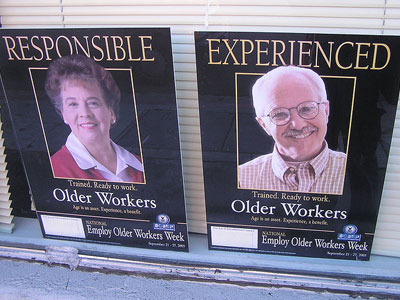With the monthly Employment Situation report due out Friday from the federal Bureau of Labor Statistics, and fresh news from payroll processor ADP that U.S. companies boosted payrolls more than expected in July, you might be looking for a new angle to the always-present jobs market story.
One theme I’ve noticed in the zeitgeist a lot lately is that of age discrimination, as mature workers (and the bar for that definition seems to be falling lower by the month) voice concerns about lack of interest or opportunity offered by employers. Veterans of every industry, from the in-person and online eavesdropping I’ve been doing, lament that companies want only “young and cheap” workers, and that even people in their 40s are being turned away or screened out as too old, out-of-touch or likely to boost benefits costs.
It’s a frightening prospect for a cohort that already is grappling with lack of preparedness for retirement and financial losses in the real estate and investment markets. Single people who don’t share household expenses with anyone are plainly frightened, as you can see in the hundreds of reader comments to this recent New York Times article, “Unemployed and older, and facing a jobless future.” Parents who had children in middle age, or those struggling to help teen and adult offspring, as well as care for aging family members, likely counted on being breadwinners into the sixties or seventies, not counted out by age 50.
Statistically, those over age 45 are experiencing a lower unemployment rate than younger workers, according to recent BLS figures on unemployment by age, sex and marital status. (Married people have an even lower rate; that might be another avenue to explore.)
So what’s the beef? Apparently there are plenty; check out these figures from the Equal Employment Opportunity Commission and note the rise in age discrimination suits over the years — they’ve climbed in number and as a percentage of the suits filed by the EEOC. The agency’s portal on Age Discrimination includes other information and data, including state statistics through FY2012, so you can see how age discrimination suits trend in your area. Check the EEOC newsroom page too, for press releases about age discrimination suits, in case any feature employers in your market. And of course, you can find attorneys who specialize in pressing and defending such cases.
Of course, check with state lawmakers and agencies about anti-discrimination rules in your state, which may be tougher than federal law– here’s a round-up from the National Conference of State Legislatures that will point you to the applicable statues. AARP is a good source of information; here’s a reference to a poll of its members on the topic; it refers to the Protecting Older Workers Against Discrimination Act — which died last year in Congress.
Also, the National Bureau of Economic Research is just out with a paper (available free to journalist) that says age discrimination laws really didn’t do a good job protecting older workers during the “severe labor market disruptions” of the Great Recession,” another analysis that would seem to support workers’ claims today.
Obviously you can talk with workers and job-seekers (try jobs fairs, church jobs ministries, etc.) about their anecdotal experiences. Services that provide application-screening software and services for employers might have some insight; recruiters might have tips on how to beat ageism — this story screams out for a couple of coping sidebars — and trade organizations and professional societies may have policies or even lobbying activity on the topic.
And we’ve got another hook: The last full week in September is the U.S. Department of Labor’s Employ Older Workers Week.











